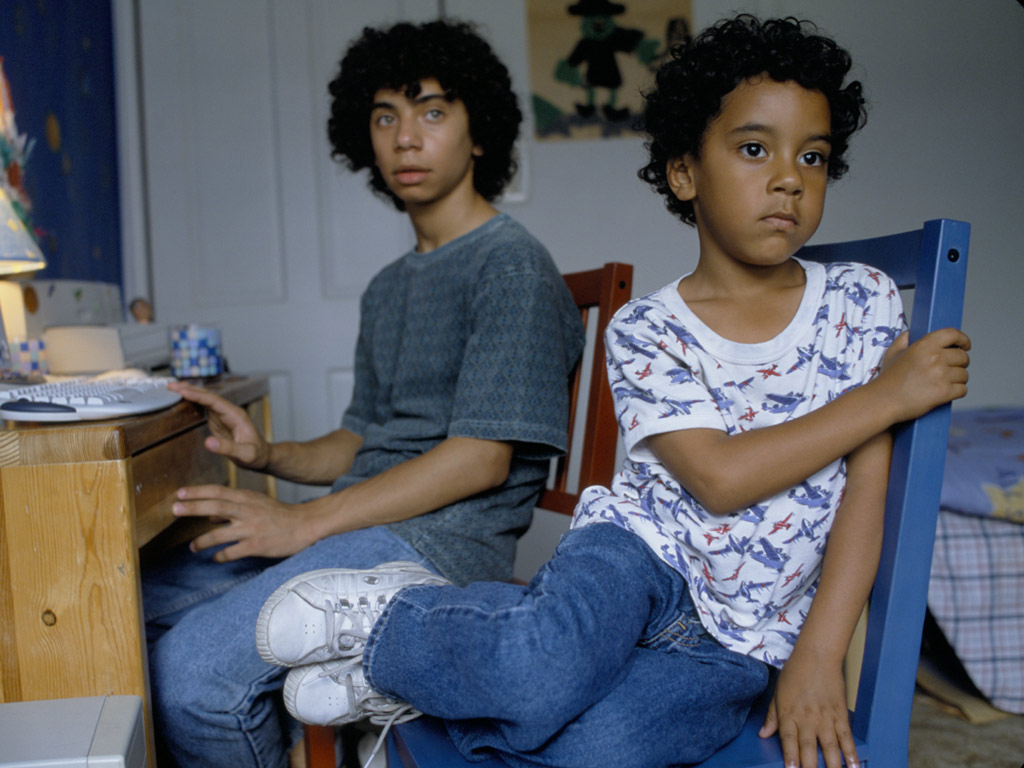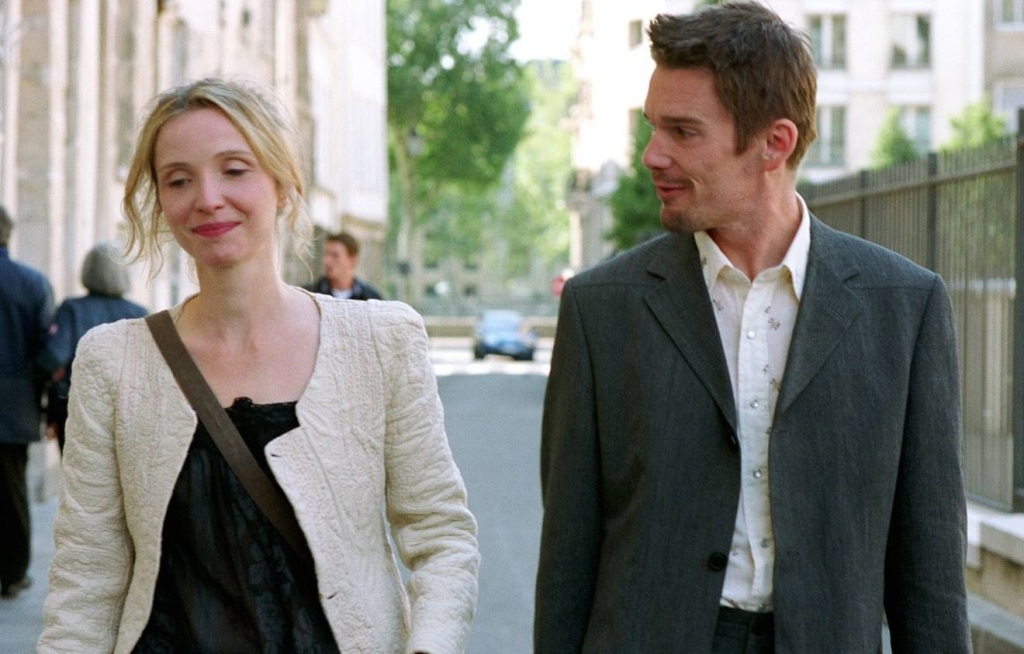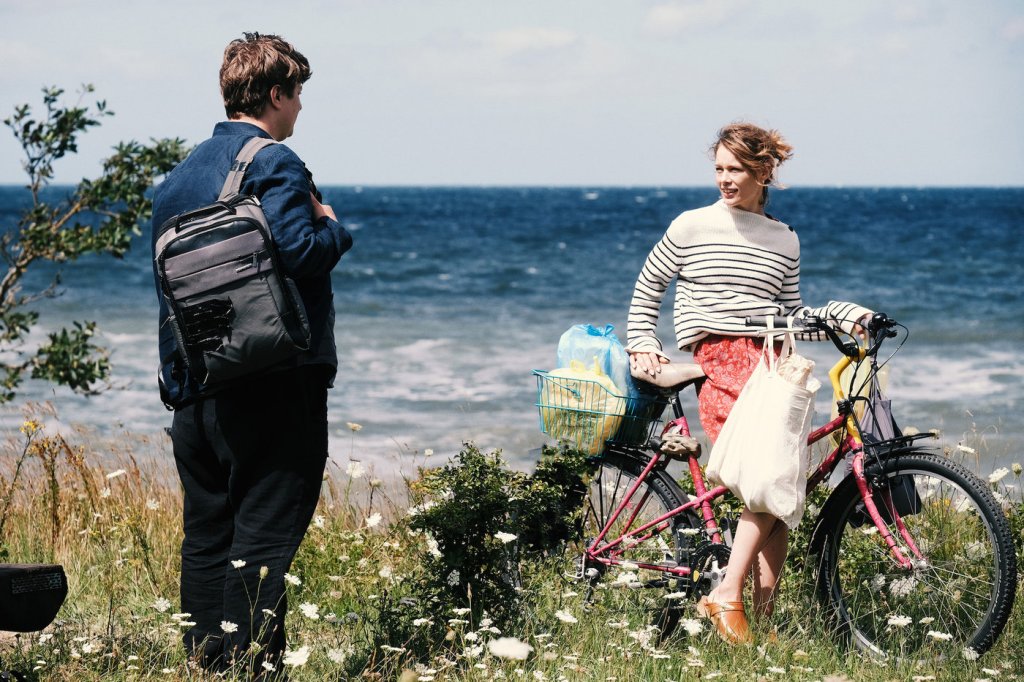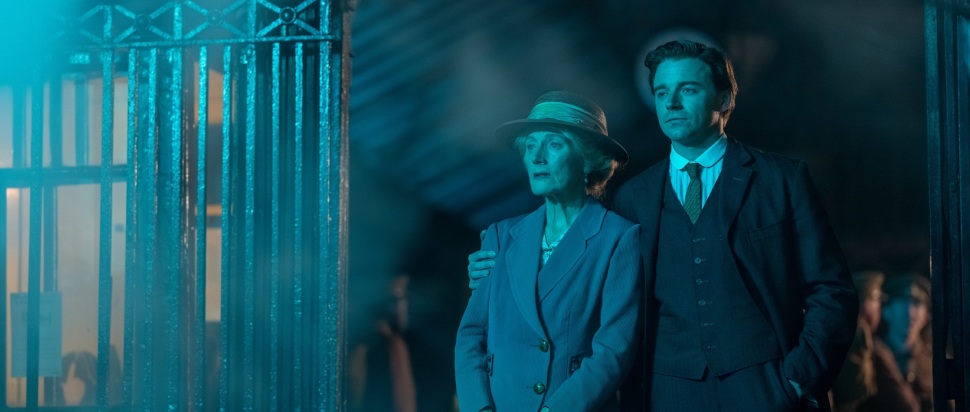
Film festivals are worlds unto themselves. Whether a weekend’s worth of programming at a local cinema or a multi-venue, week(s)-long event in another state or country, they vary substantially in size and commitment. Given time and proximity, anyone can attend a single screening at, say, the New York Film Festival but it takes a particularly devoted cineaste to spend a week-plus at Sundance or Cannes. In addition to transportation and lodging, one’s left with a spectrum of choices: If a festival’s offering 100+ titles to peruse, which ones do you see, and how many each day? Are you there entirely to watch movies or do you make time for other activities? When (and what) do you eat if you’re attending films from morning until Midnight? How will you adjust to this curious, particular mode of being often dubbed “film festival brain”?
I didn’t have a good reason or the funds to attend an out-of-town film festival until, for a few unseasonably wintry days in early November 2003, I ended up at one in Rochester, New York with a few friends from my film group Chlotrudis. The High Falls Film Festival honored and mostly focused on female directors and screenwriters. We made the six-hour trek west of Boston because one of our members lived there. This was in the days before I kept meticulous records of my viewing activity, but I probably saw seven or eight films at High Falls including the Isabel Coixet-directed, Sarah Polley-starring My Life Without Me, a limpid adaptation of the novel Balzac and the Little Chinese Seamstress, the Pilobolus/Maurice Sendak documentary Last Dance and, on closing night, a preview screening of Robert Altman’s penultimate film The Company (at the time, a letdown following Gosford Park though in retrospect, weird and gutsy enough that I keep meaning to revisit it.)
Apart from adhering to a schedule and standing in waitlist lines, High Falls felt a somewhat atypical film festival in retrospect, with lots of downtime to do all the other things a metropolis as grand as Rochester had to offer (well, at least we toured the George Eastman Museum and its film archive.) I’d come closer to experiencing “film festival brain” the following year by attending the Provincetown International Film Festival and volunteering for the Independent Film Festival of Boston. The former, concentrated in the titular coastal resort town provided the desirable closeness between hotel and cinema venues that enhances a festival while the latter lent insight regarding how much of a multi-plate-spinning, three-ring circus such an operation can be.
By 2005, I was ready to tackle the Toronto International Film Festival (TIFF for short.) One of the largest and buzziest film fests in the world, TIFF usually runs for eleven days starting on the Thursday after Labor Day. It hosts many North American premieres (at least those not earmarked for Telluride or New York) as well as some world premieres. After bowing at TIFF, the likes of Silver Linings Playbook, If Beale Street Could Talk and The Fabelmans have all instantly become serious awards contenders. Though often feted for its big-ticket gala premieres, TIFF has such a breadth of programming that there’s always something for everyone, whether it’s world cinema by directors as renowned as Werner Herzog or as obscure as Pen-Ek Ratanarung, four-hour-long Frederick Wiseman documentaries and experimental, far-under-the-radar shorts, midnight movies and independent Canadian cinema that rarely makes its way south of the border.

My first TIFF (also my first visit to Canada) was a whirlwind of sixteen films over five days and nights. Once again, I was lucky to attend with my Chlotrudis friends, some of whom were TIFF veterans by that point. Without them, navigating the fest, which then sprawled from the prestigious venues along King Street West all the way up to Bloor and over to the University of Toronto might’ve overwhelmed a newbie like me (presently, the festival is concentrated in a six-block radius near the Bell Lightbox cinema.) Actually, my own experience was still perilously close to a sensory overload, particularly concerning ticket buying. With many screenings sold out well in advance, we’d awaken near the crack of dawn every day to wait in line at the Manulife Centre lobby to see what tickets had been released for that day’s showtimes. I often didn’t know what I’d be seeing in advance and had to make snap decisions based on this same-day availability.
For me, TIFF 2005 began uncommonly strong with Wang Xiaoshuai’s coming-of-age Cannes Jury Prize winner Shanghai Dreams (which would never receive North American distribution) and ended with Terry Gilliam’s woefully bizarre Tideland. In between, some of my most-anticipated titles were disappointments: AIDS triptych 3 Needles from The Hanging Garden director Thom Fitzgerald and The Quiet, Jamie Babbit’s leaden follow-up to But I’m A Cheerleader. Other buzzed-about films such as The Squid and The Whale, Hou Hsiao-hsien’s Three Times and the documentary The Devil and Daniel Johnston fared better. Still, the act of seeing something in a full theater for the first time often enhanced the whole experience more than viewing it at a local cinema (or worse, at home) ever could. I’ll never forget watching Michael Haneke’s Cache at a sold-out 2000+ seat Elgin Theatre and loudly gasping along with everyone else at one particularly shocking moment; I walked down Yonge Street with the two friends I’d seen it with afterwards, all three of us baffled and left near-speechless by its cryptic ending.
Earlier, I mentioned that TIFF is an ideal place to discover Canadian indie films since a good portion of them never get a theatrical release (or more likely these days, streaming distribution) in the US. In 2005, at least one-third of what I watched was Canadian content (i.e. “CanCon”.) Unless you’re a Canadaphile, it’s likely you haven’t seen the delightful Eve and The Fire Horse (a Sundance Special Jury Prize winner!), the aforementioned 3 Needles or the tedious thriller Lucid, not to mention Whole New Thing (a quirky queer Rushmore), These Girls (a trifle starring David Boreanaz and Caroline Dhavernas (Wonderfalls forever!)) or the Douglas Coupland doc Souvenir of Canada (probably as CanCon as it gets.)
You likely haven’t seen C.R.A.Z.Y. either, even though its director, Jean-Marc Vallée, would go on to make Dallas Buyer’s Club, Wild and the HBO miniseries Big Little Lies and Sharp Objects. When I arrived at the festival, the curiously-titled film wasn’t on my radar at all as I was neither familiar with the Quebecois director nor the cast; collective buzz (one of my friends might’ve attended an earlier screening) and intriguing subject matter (gay coming-of-age in 1970s suburban Montreal) eventually netted my attention. On the morning of my second-last day in Toronto, I purchased a ticket for it at the now long-gone Cumberland 4. I walked out of the screening thoroughly entertained and also transformed—I declared it my favorite film of the fest (with Cache in second place and, to be seen later that day, The Squid and The Whale in third.)

C.R.A.Z.Y. is about Zac Beaulieu, the fourth child of a middle-class family of five boys. Opening with his birth on Christmas, 1960, the film spans the first twenty-odd years of his life, often jumping ahead in time to arrive at another birthday (and by default, Christmas.) Accidentally dropped on his head as a newborn, Zac is believed by his devout Catholic mother Laurianne (Danielle Proulx) to not be only “special” but also “gifted” an ability to heal the sick and afflicted with his mind. This is dubiously confirmed by the middle-aged psychic she takes him to at age six who is only referred to as “Mrs. What’s-Her-Name” (“The good Lord gave it to him!,” she declares.) At that age, Zac idolizes his dad, Gervais (Michel Côté), a masculine, blue collar semi-hipster who takes him out for french fries, blows smoke rings, listens to Patsy Cline (whose signature tune “Crazy” appears throughout) and sings karaoke along with Charles Azvanour’s “Emmenez-moi” at every family gathering. Cool Dad Gervais also obviously sees Zac as his favorite compared to his older brothers Antoine (a jock), Christian (an egghead) and Raymond (a hoodlum.)
The only problem? Zac is perceived as “different” by all the men in his family. His father gives him a table-top hockey game for his birthday/Christmas but what he really desires is a baby stroller he can use to push dolls around in. After Zac’s caught attending to baby brother Yvan in his mom’s housecoat and pearls, Gervais shouts at Laurianne, “What in heaven’s name did you do to him?” When the film jumps ahead to Christmas 1975, teenaged Zac’s (played by Marc-André Grondin from here on) bedroom is now decked out in Pink Floyd and David Bowie insignia. He intensely, loudly sings along to “Space Oddity” in his room, only to attract a crowd of snickering onlookers outside his window. At the annual extended family Christmas gathering, his cousin Brigitte brings along her handsome boyfriend Paul who catches Zac’s eye as the couple tears up the dancefloor to a Pérez Prado mambo. After the three toke up together in Paul’s car, at Paul’s insistence, the two boys share a “shotgun”—Paul puts the lit joint his mouth backwards and blow’s smoke into Zac’s. The next time we see Zac, his formerly longish hair is restyled and glammed up exactly like Paul’s.
Like many teens of his era (and beyond), Zac’s emerging awareness of his homosexuality is a gradual, gestating process rather than a sudden epiphany. In bed at night, he prays to himself, “Please, anything but that,” not even able to name what “that” is. He tries dating his friend Michelle while rejecting the advances of and then beating up Toto, a male classmate somewhat further along in decoding his own sexuality whom is bullied and regarded by Zac’s peers as a “weirdo”. Later, after Gervais witnesses him and Toto suspiciously exiting a car together, he gets sent to see a therapist. Whenever Zac takes a step forward, he ends up two steps back, telling the therapist, “I’m not a faggot” or abruptly leaving a record store when he sees Paul nonchalantly browsing the bins a few feet away. Even when the film jumps ahead to Zac’s 20th birthday, he’s still half-heartedly dating Michelle while shot-gunning another joint in the car with cousin Brigitte’s latest flame at Christian’s wedding reception.

Given his conservative, suburban and religious environment, it’s no wonder Zac struggles with this; as a gay man raised Catholic, I found it all too relatable despite being some 15 years younger and from the Upper Midwest instead of Montreal. In popular culture and general perception, Catholicism is synonymous with the concept of guilt, with all the atoning for one’s own sins, impure thoughts and so on. As an adult long since lapsed, however, it’s the preponderance of mystery and superstition that has left a lasting impact on my psyche. One of the things C.R.A.Z.Y. gets exactly right about growing up Catholic and queer is this continual push and pull between fulfilling desire and facing consequences. Just as Zac continually reinvents himself through his clothing, his hair, the music he likes and how he decorates his bedroom, there remain little reminders everywhere that God Is Watching via the excess of prominently-placed crucifixes in the Beaulieu home (not to mention the one often hanging around Zac’s neck) or other religious iconography that suffuses the film (a disapproving Gervais appearing in frame next to a painting of Christ on the wall; the mesmerizing male chorale music sung in Latin that often surfaces on the soundtrack whenever Zac is at his most conflicted.)
And if all of that wasn’t enough, he’s being asked repeatedly from a young age to pray for a sick family member or friend, placing an even heavier burden on him. Multiple times, he’s shown to even have a sort of psychic connection to his mother that’s somehow related to this “gift”: as a young boy, he furiously prays at sleepaway camp that no one discovers he wet his bed while Vallée cuts between this and Laurianne, in bed at home, violently awakening and responding to his cry for help—perhaps the one time C.R.A.Z.Y. oversteps a bit unless his mother’s actions are all in Zac’s mind (a real possibility since he daydreams more than any other movie kid since A Christmas Story’s Ralphie.) When shit gets too real (i.e. seeing Paul at the record store), Zac not only goes into panic mode but relies on the superstition informed by his religious upbringing: attempting to walk all the way home in a blizzard, he rationalizes, “I would be cured if I could simply make it through the storm.” He does arrive at home intact (if close to hypothermic), but still hasn’t entirely accepted the notion that one can’t pray the gay away.
Zac eventually gets to a place of self-acceptance, albeit one that’s not without consequences. In possibly the film’s most brutal and honest exchange, his father point-blank states that his sexuality is not something he’ll ever accept. It’s consistent with his attitude throughout: “This shouldn’t be happening to us; it’s all in his head,” Gervais tells Laurianne earlier and it’s revealing, and in a religious background all too common that what prevents Zac from fully coming out is an importance placed on how it affects others in his life rather than himself. Into my early twenties, I denied my own sexuality, being overly concerned with what my family and friends would think of me if they knew the truth. Like Zac, I conformed to a version of myself that was what I perceived the world expected of me, while also often subconsciously making decisions that brought me closer to my true self without giving the game away (in my case, growing out my hair, getting my ears pierced, covertly flirting with other men I secretly found attractive.)

Interestingly, Vallée himself identified as straight. He co-wrote the screenplay with François Boulay, who based it in part on his own experience growing up gay. I remember reading at the time that what attracted Vallée and informed his own contributions to the story was its focus on a teenage misfit, a boy whom for any number of reasons simply doesn’t fit into his narrowly defined world. While applying homosexuality to this premise sharpens the conflict and heightens the urgency of Zac’s plight, what’s remarkable about C.R.A.Z.Y. is that, in spite of this, it still eloquently brings to life an ultra-specific world one can identify and comprehend. Look past the music, the clothes and the interior design and revel in such rituals as a full-capacity church at Christmas Midnight Mass or family parties brimming with finger foods and the chaotic overlapping interactions between all the relatives. Marvel at such specifically mid-century Quebecois slices-of-life like the Beaulieu boys’ delight for their mother’s ironed toast. For all of Zac’s struggling, this world as remembered from adulthood is so colorful, vibrant and real one could almost step into the frame and feel what’s it like to be an active part of it.
Regardless, C.R.A.Z.Y. indicates that no matter what fondness or nostalgia one retains for their childhood, the most effective way into adulthood is to strike out on one’s own. After Christian’s wedding, Zac has to escape Montreal and travel all the way to Jerusalem, the Holy Land (a trip that would be at the top of Laurianne’s bucket list) to fully confront and accept his sexuality (he ends up finally sleeping with another man who naturally looks a lot like Jesus!) When he returns home, it’s clear he has changed but Montreal hasn’t. Laurianne asks him to pray for Raymond, now a junkie and near death, in order to “heal” him, but of course it doesn’t work. And while Gervais makes his nonacceptance of Zac clear after he returns, he still tears up and hugs him at Raymond’s funeral. In the final scene, we see a present-day Zac and Gervais getting fries together like they did back in the day; Zac’s voiceover mentions that they still don’t discuss his sexuality but in a decade’s time after the funeral, Gervais became more tolerant of it, even allowing one of Zac’s boyfriends into his home.
I haven’t even gone into entire subplots about Zac’s temperamental relationship with Raymond, or the saga of the broken Patsy Cline record, or his Midnight Mass daydreams (the entire congregation woohoo-ing along to “Sympathy For The Devil”) or how little Yvan’s most identifiable trait is his incessant eating. At just over two hours, the film packs in ample plot and character development but rather than feeling overstuffed, it resembles an invitation full of goodwill, all the way to its clever reveal at the end of what the title’s initials mean (think about it.) Winner of Best Canadian Film at TIFF 2005, it became a massive hit in Quebec, earning $6.2 million there (the equivalent of a film grossing over $300 million in the United States today) and won 10 Genie awards (the Canadian Oscars.) I ended my initial review by noting, “It would be crazy if it never received US distribution,” but that’s exactly what happened, mostly due to music rights (in such a large market, Pink Floyd wasn’t going to give away “Shine On You Crazy Diamond”, one of the film’s most essential needle drops, for a pittance.) It did receive a domestic DVD release in 2007 and is streaming on Max at this writing. I screened it for the first time in nearly 15 years after Vallée suddenly died of heart failure in late 2021; for all his subsequent work and acclaim, it remains his best film perhaps because it’s his most personal. As much of it is a feast for the eyes and ears, one simple exchange between Zac at 15 and Mrs. What’s-Her-Name (of all people) gets at the heart of how beautifully C.R.A.Z.Y. acts as (what Roger Ebert once said of film in general) an “empathy machine”:
Zac: “I want to be like everybody else.”
Mrs. What’s-Her-Name: “Thank God, you never will.”

Essay #17 of 24 Frames.
Go back to #16: Me And You And Everyone We Know.
Go ahead to #18: My Winnipeg








































